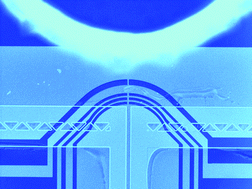Room temperature UV adhesive bonding of CE devices
Abstract
A simple low temperature adhesive ‘stamp-and-stick’ bonding procedure for lab-on-a-chip glass devices has been tested for capillary electrophoresis applications. This technique involves use of a mask aligner to transfer a UV-curable adhesive selectively onto the top CE substrate which is then aligned with and bonded to the bottom CE wafer. The entire bonding process can be carried out at room temperature in less than 30 minutes, involved only user-friendly laboratory operations, and provided a near 100% success rate. CE microchips made in this manner exhibited similar electroosmotic flow and separation characteristics as ones made via conventional high temperature thermal bonding. Equally important, the devices provided stable long-term performance over weeks of use, encompassing hundreds of individual CE runs without structural failure or any apparent change in operating characteristics. Finally, these devices exhibited excellent chip-to-chip reproducibility. Successful adaptation of the stamp-and-stick approach did require the development and testing of new but easily implemented structural features which were incorporated into the chip design and whose nature is described in detail.


 Please wait while we load your content...
Please wait while we load your content...